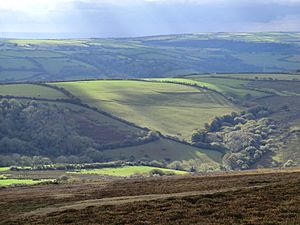North Exmoor SSSI facts for kids
| Site of Special Scientific Interest | |
 |
|
| Area of Search | Somerset & Devon |
|---|---|
| Coordinates | 51°10′25″N 3°43′05″W / 51.17361°N 3.71794°W |
| Interest | Biological |
| Area | 12,005.3 hectares (120.053 km2; 46.353 sq mi) |
| Notification | 1954 |
North Exmoor is a huge area of special natural beauty. It covers about 12,000 hectares (that's like 30,000 football fields!). This land is officially known as a Site of Special Scientific Interest (SSSI). It was first recognized as an SSSI in 1954.
This amazing place is found in Devon and Somerset, within the beautiful Exmoor National Park. It includes famous spots like Dunkery Beacon, which is the highest point on Exmoor. It also has the Holnicote and Horner Water areas, which are very important for nature. Another key part is the Chains, which is special for its geology.
Contents
What is an SSSI?
An SSSI stands for Site of Special Scientific Interest. It's a special tag given to places in the UK that have rare wildlife, plants, or important geological features. These sites are protected by law. This helps make sure they stay healthy and safe for future generations.
Why is North Exmoor Special?
North Exmoor is super important for many reasons. It has unique types of open land called "lowland heath." These areas are home to special plants and animals. The site also shows how different habitats blend together. You can see ancient woodlands turn into high-up open moorland, and then into wet, boggy areas called "blanket mire."
Amazing Animals and Plants
This area is a fantastic home for many creatures. It's especially important for different kinds of birds that nest here. You might spot many rare birds if you visit!
North Exmoor is also famous for a very rare butterfly. It's called the heath fritillary (Mellicta athalia). This butterfly needs specific plants to live. The special habitats here help it survive.
The woodlands, especially around Horner and Hawkcombe Woods near Porlock, are very old. They have an amazing variety of lichens. Lichens are small, plant-like growths that often look like moss or crusts on trees and rocks.
Deep Peat and Ancient Clues
The Chains area of North Exmoor is special for its deep peat. Peat is a type of soil made from partly decayed plants. Scientists can study this deep peat to learn about plants that lived thousands of years ago. This helps us understand how the environment has changed over time.
Wild Animals of the Moor
The ancient woodlands are open to the moorland. This means wild animals can roam freely. You'll often see red deer (Cervus elaphus) here. There's a large population of these majestic animals. Farm animals also graze in some parts of the woodland, helping to keep the habitat healthy.
Looking After North Exmoor
The whole North Exmoor SSSI is divided into smaller sections. A group called Natural England regularly checks on these sections. They make sure the special habitats and wildlife are being looked after properly. Their job is to protect these important natural places.

